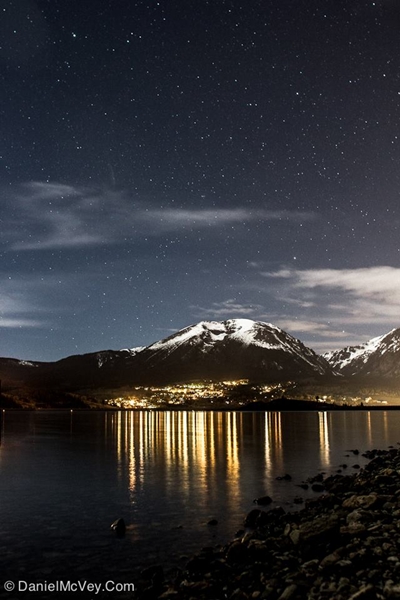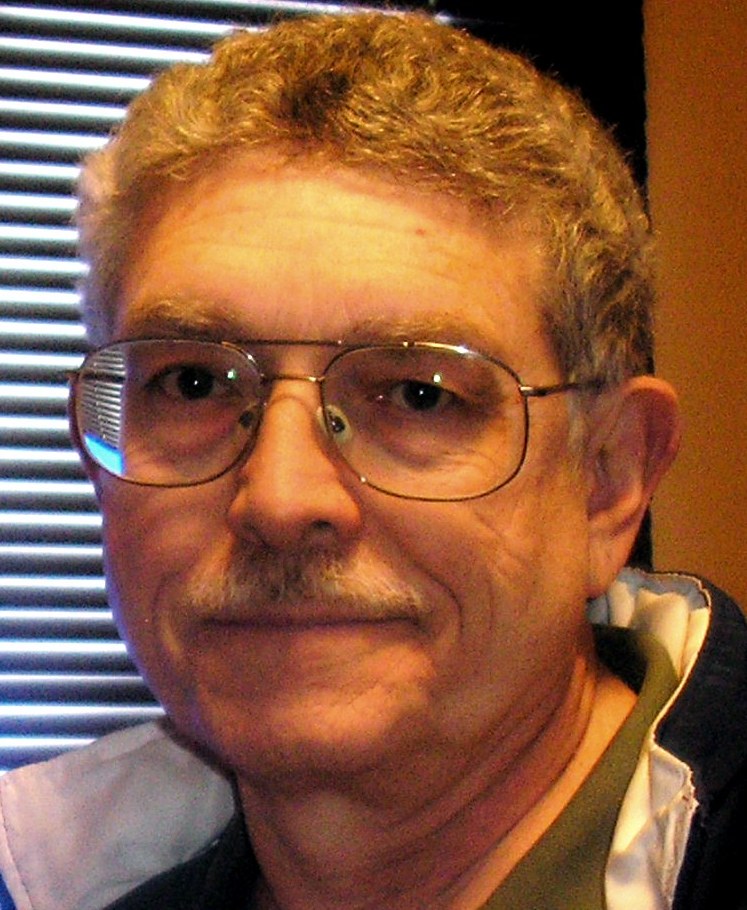Report
By Larry Sessions
I started teaching online astronomy classes for the Community College of Aurora (Colorado) and Metropolitan State University of Denver more than 15 years ago. Teaching an observational science through the Internet can be a particular challenge because I have always felt the need for students to have some kind of real introduction to the night sky, rather than just textbook exercises.
 |
| The loss of dark skies is not just a problem in big cities. Light pollution encroaches even on pristine wilderness areas. Here the lights of Wildernest, a vacation condominium community at the foot of Buffalo Mountain at Silverthorne, Colorado, are reflected on Dillon Reservoir. Just beyond the right edge of this image, the lights of Silverthorne proper further hinder the view of starry skies. But beyond the glare of electric lights, above the Eagle's Nest Wilderness, shine some the fainter stars in Canis Minor, Gemini, Monoceros and Orion in this stunning shot by Daniel McVey. Photo courtesy of Daniel McVey, www.danielmcvey.com and www.facebook.com/photographybydanielmcvey. |
Because of this, I developed a series of activity assignments that require students to make some simple observation or perform some simple experiment on their own. Students estimate the altitude and azimuth of stars and the Moon, "weigh" the Earth with a simple pendulum, and measure the circumference of the Earth using a simulation of Eratosthenes' famous experiment. Due to the nature of the activity, some of these (e.g., the Eratosthenes observation) are geared toward students in the Denver area, or require significantly more time on my part checking the results if the student in not in the immediate Denver area.
Unfortunately (or fortunately, depending on your outlook!), my students also are sometimes dispersed across the planet. Some students have taken my online courses from as far away as Thailand, Borneo and the Amundsen-Scott South Pole Station. As such, I cannot require students to come onto campus for observational activities, and I cannot require them to have access to a telescope. I must design or choose my activities carefully. Needless to say, I was intrigued and eager to try the Globe at Night program when I first heard of it a few years ago.
Since then, I have made it a required activity whenever our scheduling allows. Students enjoy it and feel that it is very worthwhile. It gives them a sense of accomplishment and satisfaction that they have gathered data with other observers around the world. I like it because:
1) It is simple and easy to understand
2) It can be done from virtually any location on Earth
3) It requires no special equipment
4) As "citizen science" it provides valid scientific data
5) It increases the awareness of the insidious increase in light pollution
6) And most of all, it gets students out to observe the real sky
To be honest, until recently it has been a little hard to gauge actual student participation because the Globe at Night database was understandably not available until after the end of most semesters. A year or two ago someone gave me the excellent suggestion of requiring my students to include a special code in the comments of their submissions so that I can more easily track them down in the data. This is a great idea, but unfortunately it does not solve the timing problem because my grading periods often end before the Globe at Night program period is complete and the complete database made available. However, the situation has improved greatly because now I can open up the current participation map and click on the various dots in my area to locate particular student submissions shortly after they have been made.
On the personal side, I've been painfully aware of the loss of dark night skies for many years. I live in a fairly secluded area of Denver, in the city proper but near a half-mile stretch of an unlit running path along a stream. At the south end is a large park. About 20 years ago I was able to glimpse the Milky Way, but today I don't even bother. While it is relatively dark at my location, today I might be able to catch a 3.5 magnitude star under the best of conditions. Under truly dark skies, an observer with average eyesight should be able to see stars 10 times fainter.
The problem with light pollution is that most people do not know it is happening, and every year there are fewer and fewer people who even remember dark skies. In essence, the public do not know what they are missing. The only hope is to educate, and instill an awareness of all we are losing. Globe at Night can be a powerful tool in that quest.
###
 Larry Sessions is an astronomy educator and former planetarium director in Denver, Colorado. He has written and lectured about astronomy and space, and has promoted a greater awareness of science and in particular the starry night, for more than 40 years.
Larry Sessions is an astronomy educator and former planetarium director in Denver, Colorado. He has written and lectured about astronomy and space, and has promoted a greater awareness of science and in particular the starry night, for more than 40 years.
My Recent Reports
Contact
| Location: | Sri Lanka  |
|---|---|
| Website: | thilinaheenatigala.blogspot.com |







Comments